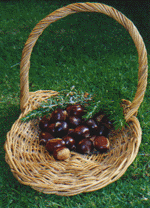 |
 |
 |
|||||
|
©Chestnut Traders 2002 |
No one is certain when the first chestnut trees were imported into New Zealand. One of the oldest known trees was in Brooklands Park, New Plymouth, which had been planted in 1847, and reached a diameter of 2.29 metres. Another well known specimen is in Wanganui: "It was planted by Major Nixon over 100 years ago, and can be seen growing at the roadside at the end of Sedgewick Street" . By the 1880s, at least one nurseryman was offering all four main species: Castanea dentata, C. crenata, C. mollissima and C. sativa. A number of trees planted by early settlers still grow in many parks, farms and gardens throughout the country. However today, aside from recent importations, only trees of the European and Japanese species and natural hybrids that have occurred between them can be found. Chestnut trees will grow well across most of New Zealand, but only produce good quality nuts reliably each season in some regions. There is still a significant amount of work to be done in assessing the viability of commercial production in some areas or sites. From 1975, the New Zealand Tree Crops Association (NZTCA) started recording chestnut trees that appeared to have some commercial potential, based largely on nut size, but also including shape, splitting, mutli-embryonic tendencies, pellicle intrusion and colour. Today's principal cultivars 1005 and 1015 were first recorded by NZTCA in 1977. Propagation of recorded chestnuts started about 1977, and small commercial trial plantings began about 1980. Most orchards have been established in the Waikato, Bay of Plenty and Rotorua areas. There have also been plantings in Hawkes Bay, Horowhenua and Canterbury. Recently there has been significant new planting in the Auckland area. New Zealand is free from most disease and pests that have plagued the traditional chestnut-growing areas. In particular there is no chestnut blight (which has all but wiped out the American chestnut in the US, and is severely depleting yields in Europe) and the gall wasp is not established. Three common Euro-Japanese hybrids, known as cultivars 1002, 1005 and 1015, form the basis of today's commercial plantings and account for in excess of 95% of the total crop (see table).
There are also some varieties of Japanese chestnut (cultivars 902, 905 & 907) in New Zealand's orchards, although generally not in commercial quantities. Although they produce very large nuts, their performance has been erratic, and the trees are not as hardy or adaptable as the hybrids. There are no reliable figures as to the production from each region. Estimates suggest that total production is in excess of 300 tonnes per year, perhaps split Waikato 45%, Bay of Plenty 40%, Auckland less than 10% and South Island less than 5%. The harvest season varies according to the weather, the altitude and the latitude, but only by about three weeks. For example
Industry OrganisationChestnut growers are encouraged to belong to the New Zealand Chestnut Council (NZCC), the recognised industry body. Chestnuts are a product group organised under control of the Horticulture Export Authority (HEA), controlled by its own Act of Parliament. All exports must be undertaken by a licensed exporter, who must be registered with the HEA and the appropriate product group. Each product group develops an Export Marketing Strategy (EMS). HEA and the EMS are designed to ensure quality standards are maintained, and that marketing is orderly. Neither HEA nor NZCC undertake any marketing in their own right. Private individuals and companies undertake this. Exporters must be licensed with HEA and NZCC, and must adhere to the EMS.
|
Home | About Us | Products | The Chestnut | NZ Chestnuts | Quality | Recipes | Contact Us
